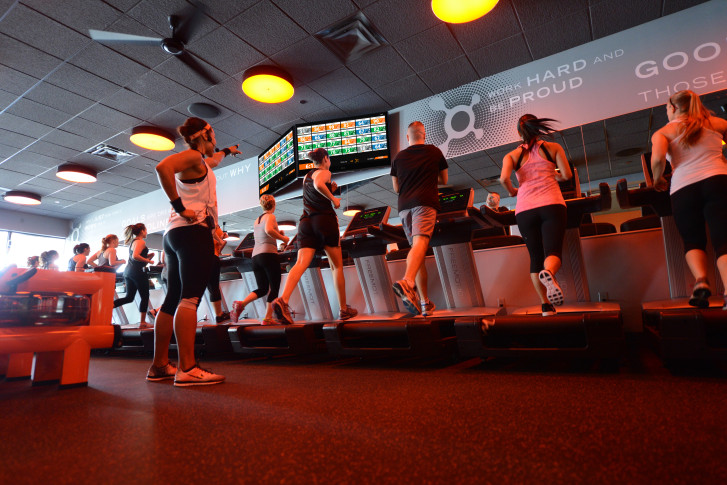
Orangetheory, the latest fitness class craze, is leaving its clients seeing orange. (Courtesy Linda Roth Associates)
WASHINGTON — Whether the preference is spinning, stretching or lifting legs over a ballet barre, one thing’s for sure: Boutique fitness studios are winning over the District.
And the latest class craze is leaving its clients seeing orange.
Orangetheory Fitness first made its mark in the D.C. area in 2013 with its Fairfax, Virginia, studio. Since then, the Florida-based franchise has opened 10 locations around D.C., Maryland and Virginia, and has plans to more than double that number by next year.
Orangetheory shares many similarities with its competitors: The classes feature loud music and dim lighting; screens displaying each participant’s workout statistics hang on the wall for all to see. What’s different is that the motivator is a color: orange.
Before class, each participant is given a heart rate monitor and assigned a maximum heart rate based on their age, weight and sex. Throughout the 60-minute interval workout — which bounces between a treadmill, a rowing machine and floor/weight exercises — participants spend time in the different color-coded heart rate zones, illustrated on the screens.
Gray is the resting zone, blue is for warming up and green is considered the base pace. The two most important zones are orange — the “push pace,” which is 84 to 91 percent of your maximum heart rate — and red, which is considered “all-out.”
“A lot of people go to the gym and they workout for 20 minutes on a treadmill and they say, ‘Yeah, I worked out.’ This is actually telling you — physically showing you — what zone you’re in and what’s actually happening as you work out,” said Brittany Collins, studio manager of Orangetheory’s Mount Vernon Triangle location in Northwest D.C.
In addition to burning calories in class — an estimated 500 to 1,000 per hour — Orangetheory’s claim to fame is the workout’s ability to burn calories long after the treadmills are turned off.
Collins explains the production of excess post-exercise oxygen consumption, or EPOC, keeps one’s metabolic rate elevated for 24 to 36 hours after the workout is done. EPOC is generated while one is in the “orange zone,” so the more time spent in orange and red makes it more likely to burn calories after class is complete.
“That is what Orangetheory is all about. These are scientific workouts that have been researched and proven to the most efficient workout in that interval training,” Collins said.
To keep track of how much time is spent in these target zones, participants are awarded one point for each minute they exercise in orange or red. The goal is to accumulate at least 12, which is achievable, but not without some sweat equity.
At a recent class in D.C.’s Orangetheory studio, head coach Muhammad “Coach Moe” Kamara led 13 people through an hourlong “power” workout consisting of running sprints, rowing bursts and a number of plyometric exercises.
“Most people sit at a desk all day, most people sit on the couch all day, and so in [class] is where they get to really work their heart rate, increase their heart rate and help them burn calories and burn fat, as well as increase their metabolism, which is going to help them long-term — after the class is over, when they’re sleeping. That’s what we’re about,” Kamara said.
Kamara’s job is to call out the appropriate times for all-out exertion — and modifications for those who have injuries or who prefer power walking at an incline over running. But it’s up to the individual to put in the maximum effort — and to pull back when advised.
“It’s that interval, in and out, that’s important to really maximize the calorie burn and the afterburn,” Collins said.
The cost of Orangetheory Fitness varies based on studio location, and the information is not available on the website. Class bundles are offered at a discount, but a drop-in rate runs about $32 for the hourlong session.
http://wtop.com/fitness/2016/08/orangetheory-latest-fitness-craze-leaves-participants-seeing-orange/
Click Here For More Articles

No comments:
Post a Comment